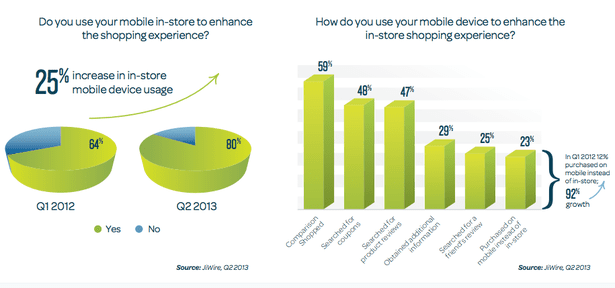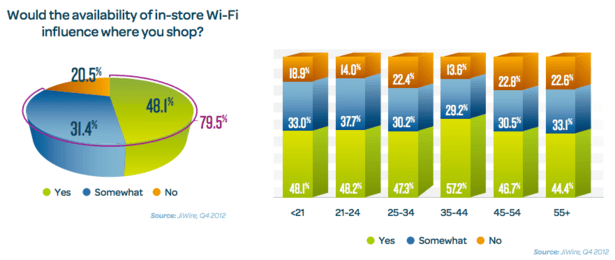Using the right technology is key to optimising multi-channel retail strategy
Understanding the full impact online activity is having on offline sales has become something of a holy grail amongst marketers. Online advertising platforms, whilst bringing far greater measurability for those customers who click and convert online, cannot yet integrate all offline sales that have been influenced by web activity.
It’s certainty a pressing issue. According to a Forrester study, more than 50 percent of U.S. offline retail sales will be influenced by the Internet by 2017; a practice known as webrooming. Those web-influenced sales will also rise to $1.8 trillion, up from $1.2 trillion in 2012 – to put that into perspective, total ecommerce sales alone are set to reach $370 billion by 2017.
Another study also charts the rise of the showroomer: those who browse in-store before making a purchase online. There are multiple reasons why consumers might engage in this activity (like the ease of being able to shop around for the best price, or the convenience of researching products independently before purchasing), all of which require extra effort for marketers who want to make sure people do finally purchase at their online store.

Source: JiWire
Thankfully, there are a growing number of sophisticated techniques that allow us to capture offline data and attribute it correctly at the point-of-sale. And the better an advertiser can track the full customer journey, the more effectively the advertising budget can be allocated.
Here’s an overview of the best techniques for capturing the behaviour of both webroomers and showroomers.
Three Methods For Capturing Webroomers
Those who: research online – purchase offline
Loyalty Schemes
Loyalty or members’ schemes are an ideal strategy for marketers who want to attribute an in-store sale to that user’s previous online interactions with the company.
How does it work?
When an offline sale occurs, it gets scanned onto a loyalty number, or attached to a unique ID. This identifier then connects the purchase back to a PPC ad, or an action taken on the website (provided the user is a member and was logged in at the time). This method can also work for advertisers who email receipts, since this unique identifier can be attached to a sale and tracked online.
Case study
Setting up an online loyalty scheme is much easier and quicker than with physical cards. SaaS based platforms like Sweet Tooth, for example, don’t actually require a card – instead, points get added to a user’s account via POS integrations, making the experience much more convenient for the customer.
Mogl takes a similar approach to online and offline tracking via a cash-back loyalty programme. Say a user is walking past a restaurant, the platform could send an ad to their mobile offering them 15 percent cash back if they visit right away. Since accounts are linked via the customer’s credit or debit card, as soon as the waiter swipes the card, the customer will see a notification on their phone that they’ve just earned 15 percent cash back on their next meal (and the advertiser will see that their online ad converted).
Coupon Codes
Coupons are a great opportunity for retailers who want to advertise online for a discount on in-store sales, and track the results of the campaign.
How does it work?
A unique coupon code gets generated for each of your PPC ads (or for every keyword, if you want more granular data). The customer then uses this code to claim the discount, either over the phone or in-store. Each code that converted gets linked back to the ad to calculate your ROI.
Case study
Meat Pack, a Guatemalan shoe retailer, ran an innovative coupon campaign that offered shoppers a discount in their local store. What made this campaign interesting, was that Meat Pack determined how large their discount would be depending on how much time it took the shopper to physically enter the store. They were offered a 99% discount upon receiving the ad on their mobile, and this reduced by 1% every second, meaning the user would have to run to the nearest store.
Call Tracking
Just like coupons, call tracking software offers retailers the chance to link contact centre sales back to the online activity that inspired the call. According to a report from call tracking provider ResponseTap, 52 percent of marketers say they still don’t have a complete view of how their online and offline marketing activity is driving phone sales.
How does it work?
Dynamic phone numbers are generated for both your website and your PPC ads, meaning each call can be routed back to the source. By linking calls to the online journey, you can see the keywords they used, what pages and clicks inspired a call, which pages they are viewing during the call, and what they do after the call.
Using this data not only helps you track the customer journey, it also means you can improve it in real-time. For example, say a customer is researching a holiday in Italy: that call can be routed directly to the rep best suited to deal with Italian sales. A piece of software known as a “call whisper” feeds the rep data about the customer prior to the call, meaning they immediately understand their requirements.
Three Methods for Capturing Showroomers
Those who: purchase online - research offline
Beacon Technology
For customers who have an account with you online, beacons offer an opportunity to target these people as soon as they walk into your brick-and-mortar store.
How does it work?
Beacons are a low-cost, location-based technology that communicate by Bluetooth with smartphones and other beacon-enabled devices. Purchasing incentives can then be sent to the shopper as they browse the physical store. As well as sending people push notifications in real time, beacons also allow marketers to measure what percentage of their online customer base actually walks through their doors.
Case study
House of Fraser introduced beacon-equipped mannequins to its Aberdeen store, which activated as soon as a customer walked within 50 metres. Push notifications were then sent out to their mobile with information about the clothes the mannequin was wearing, the price, and links to the product pages on the website.
Wi-Fi
Offering Wi-Fi in-store doesn’t just create an incentive for people to shop with you, it also allows you to collect data about people’s offline shopping habits and attribute it to an online purchase.
 Source: JiWire
Source: JiWire
How does it work?
The wireless card in people’s smartphones is detectable by in-store routers. This means that once a customer enters the store with Wi-Fi turned on, the router creates a unique ID number for that device which can be used it to keep track of people as they browse. Also, since customers need an email address to log in, this can be used to identify them online after they leave.
Case study
Nomi is an application that uses Wi-Fi to track customers’ behaviour in a store, but goes one step further by matching a phone with an individual. As soon as a shopper has volunteered some personal information, either by downloading a retailer’s app or providing an email address when using in-store Wi-Fi, Nomi pulls up a profile of that customer. The store can now use this profile to offer personalised recommendation based on purchase history and in-store habits.
QR Codes
QR (Quick Response) codes are essentially a unique barcode that gets added to product packaging, pamphlets, and other in-store print media, allowing you to track how offline marketing activity is affecting your online sales.
How does it work?
The QR code contains an incentive which the customer scans on their mobile to get a hold of. This then performs a desired action, like taking the user to a web page, taking them to an app or loyalty sign up page, or offering them a discount on a product within the ecommerce store.
It’s also good practice to add tracking to your QR codes so you can see exactly which offline source is generating the most customers. UTM parameters appended to the URL mean you can track the QR campaign in Google Analytics. However, be sure to add a URL shortener like Bitly, otherwise the code can end up being too dense and hard to scan. Once done, you can easily create QR codes for your campaign through sites like QR Code Generator (free) or Kaywa.









